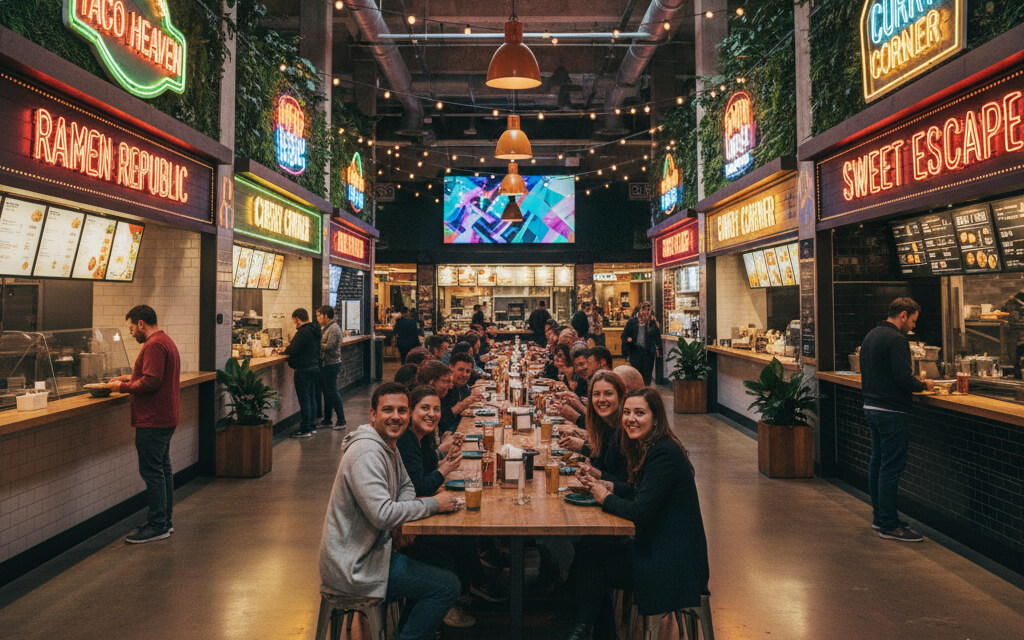October 14, 2025

The growth of food halls isn’t just a passing trend—it’s a profound shift in consumer dining habits and the restaurant business model. To really understand their rise, we need to dive deeper into the broader cultural and economic changes that have driven this evolution and how independent restaurants can truly capitalize on these shifts.
Food halls aren't just about a variety of food under one roof. They represent a microcosm of what consumers want today: flexibility, accessibility, and community. Let’s break this down:
In today’s highly interconnected, globalized world, the modern diner wants the freedom to explore and customize their food experience. The food hall concept allows them to do this in a way that traditional restaurants do not. It taps into the millennial and Gen Z mindset of constantly seeking new experiences rather than settling for predictable dining options.
For independent restaurant owners, understanding this desire for variety can encourage them to expand their thinking beyond a single cuisine or dish. This doesn’t necessarily mean opening multiple concepts, but pivoting your menu regularly and offering themed nights or specials that let customers explore different culinary worlds.
For more ideas on rotating menus, check out The Best Local Marketing Strategies for Independent Restaurants, where they discuss how cross-promotions can also drive engagement.
Experiential dining has transcended mere food quality. The ambiance, interaction, and emotional resonance of a dining experience are just as important, if not more so. Food halls capitalize on this by integrating art, entertainment, and design into the dining environment.
Think about the post-pandemic longing for human connection—after months of isolation, many diners are looking for more than just a meal. They want an experience that helps them socialize, connect, and feel like they belong. Food halls foster this sense of community by:
Independent restaurant owners can enhance the dining experience by focusing on creating a welcoming atmosphere, whether that means hosting local artists, curating playlists, or introducing elements of theater or performance into the meal. Interactive dining experiences (like allowing customers to cook or assemble parts of their meal) can also be a huge draw.
To learn more about creating this experience, explore The Best Local Marketing Strategies for Independent Restaurants, which gives specific tips for building community and a strong local presence.
While opening a food hall isn’t feasible for most independent restaurants, the principles that make food halls successful can still be translated into traditional restaurant models. Here are a few advanced ideas and refined strategies that go beyond the basics:
A rotating menu isn’t just about novelty—it's about engaging your audience in an ongoing conversation. If you run a restaurant, you can build anticipation by offering:
This strategy not only keeps your regulars coming back, but it also encourages new customers to try your restaurant out of fear of missing out (FOMO). For additional inspiration, Why Small Restaurants Must Invest in Online Ordering provides great examples of how rotating specials can be a key element in driving foot traffic.
Food halls succeed because of their collaborative nature. You might not be able to bring your neighbor café into your restaurant, but you can still build strong, mutually beneficial relationships with nearby businesses. Consider:
To learn how local partnerships can work for you, check out Best Local Marketing Strategies.
While food halls shine in the in-person, physical experience, independent restaurants can replicate this seamless interaction in the digital realm. By integrating digital tools like:
You can replicate the convenience of a food hall while keeping the personal touch that independent restaurants are known for.
Having a strong local presence is not just about showing up on Google searches. Consider:
For tips on optimizing your restaurant’s online visibility, visit Moz Local and learn how you can make sure your business shows up when diners search for you.
We’re heading toward a new era where hybrid dining concepts dominate. These are spaces where food, culture, and entertainment merge seamlessly—much like a food hall but with the unique voice of independent restaurants. To stay relevant, independent restaurant owners must:
For ideas on how to blend dining, entertainment, and digital experiences, Timeout Market Lisbon is a perfect example of a hybrid dining experience.
The food hall revolution is a blueprint for independent restaurant owners who are eager to evolve and adapt. By focusing on variety, creating unforgettable experiences, and building community, you can set your restaurant up for long-term success. Keep an eye on the future of hybrid concepts, and don’t be afraid to experiment with new ways to connect with your audience.
As food halls have shown, it’s not just about the food—it’s about the entire journey: the flavors, the connections, and the stories shared around the table.
Stay up to date with the latest tips, expert insights, product reviews, and step-by-step guides to help you grow, create, and succeed—no matter your industry or passion.